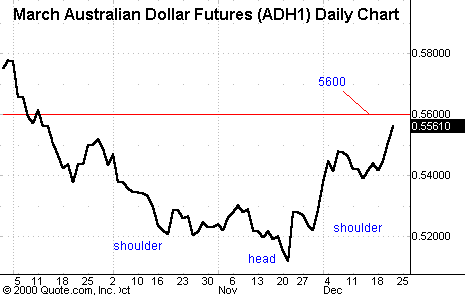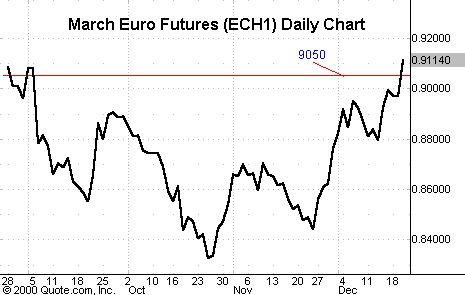Watching Macro Indicators: The Dollar
This lesson
was first published on Dec. 23, 2000.
In my books and courses I have emphasized how critical it is for equity
investors to watch bonds and short-rates within a given country. Another
critical macro indicator that stock traders and investors need to watch is the
local currency. The currency with which stocks are evaluated is a critical
part of its valuation base.
This year, a good example of how important looking at the local currency can
be in evaluating equities is shown by the French CAC 40 index. In local terms,
the index is actually up around 1% for the year 2000, and technically, it
doesn’t look too bad. But in dollar terms, the index looks horrible technically,
and it is actually down nearly 12% on the year. The bottom line is that if you
want to maximize your gains, you shouldn’t neglect major trends and major shifts
in trends of the currency underlying equity values in the stocks you trade.

For U.S. investors, that means watching the dollar closely. The two critical
things to watch for are a strong bear trend in the dollar, or a large group of
foreign currencies all breaking out of basing patterns at nearly the same time
against the dollar, which would indicate a change in trend in the dollar from up
to down.
In the last few weeks, many major foreign currencies have either broken out
of major bottoming patterns, or are close to doing so. This means that further
downside action in the dollar will shift the odds clearly to the side of the
dollar topping out and heading lower. A weak dollar will lead foreign investors
to reevaluate U.S. stocks. It may also be an indication that foreign holders of
U.S. stocks are starting to dump them — and may, in fact, suggest and show a
huge supply of stock that is being, and will continue to be, dumped on the market
if the dollar continues to weaken. So watching the dollar is now critical for
U.S.-based investors.

The Australian dollar (AUD) has already broken out of a small
head-and-shoulders bottom. A large and major head-and-shoulder bottom will be
formed if the AUD breaks out strongly over the 0.56 level. Investors without
access to forex levels can also watch nearby currency futures markets for the
same patterns. So far the euro, Swiss franc, British pound and Australian and NZ
dollars are all forming major bottoming formations against the dollar and are
close to breakout levels. If all of these currencies break out, it will be
strong evidence that the uptrend in the dollar, which has been a critical
component of the bull market in U.S. stocks for the last few years, is over and
a new sideways-to-bearish trend in the dollar is emerging.
Here are some critical levels for investors to watch. If nearby euro futures
close over 9050, nearby Swiss franc futures close over 6020, nearby dollar index
futures close below 111.50, nearby Australian dollar futures close above 5600
and nearby British pound futures close above 149.00, then the verdict will be
that the U.S. dollar has likely peaked. Investors should then be very wary of
U.S. stocks. They should also look more favorably on foreign stocks and the
technicals of foreign stocks. Bond investors should also shift out of U.S. bonds
and into funds like BEGBX that favor European bonds.

A breakdown in the dollar will not be good news for U.S. stocks. Investors
are advised to carefully monitor the dollar now. If all of the currency markets
mentioned close beyond the critical levels indicated above, investors, should
assume that the odds substantially favor that the dollar bull move, which has
been a critical component of the bull market in stocks since 1995, is over.
Investors need to continue to monitor currency values, especially the local
currency of the markets they are investing in. Whenever a large number of
currencies all show major basing or topping patterns at the same time, and then
all break out of those bases in the same direction with a week or two of each
other, the odds heavily favor a new trend emerging. Investors need to be aware
of new trends in currencies and learn to take advantage of them, not be hurt by
them.

Stock markets whose currencies are in bull markets vs. your local currency
have the wind at their backs. Investors should carefully look for strong
technical trends in stocks of those currencies. Similarly, stocks denominated in
currencies that are undergoing bear markets vs. most other currencies have the
wind in their face. Gains are difficult and it takes an extremely powerful bull
market to overcome serious currency headwinds. A peak in a currency that has
undergone a very long bull market is often an indication that global investors
are beginning to unwind big positions in stocks of that nation. It is therefore
an indication of a potentially huge supply of stock.
